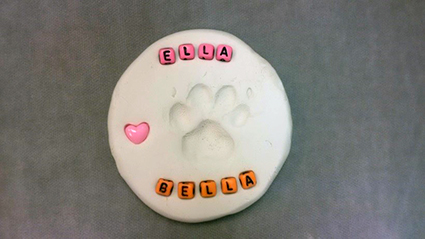Memorializing Your Pet

Memorializing Your Pet
Since antiquity, humans have memorialized animals. Dog and cat graves have been found in Germany, Cyprus, and China dating from nearly 10,000 years ago. Ancient Egyptian tombs contain mummified remains of dogs, cats, and pet birds. The oldest, continuously operating pet cemetery is just north of the Animal Medical Center in Hartsdale, New York and has been in operation since 1896. At AMC, we often make a clay paw (shown here) to memorialize our patients. Sunday, September 10th is National Pet Memorial Day and to help honor pets who have crossed the Rainbow Bridge, I have collected some ideas for you on how to memorialize your favorite fur baby.
Create a Memory
Use the jangling mass of tags from your pet’s collar to form the basis of a memory bracelet. Hunt down animal-shaped charms or ones that remind you of your pet – like a fire hydrant, tennis ball, or the mouse your cat lovingly left for you on the back porch. If you already have a charm bracelet, have a custom charm made incorporating your pet’s photograph.
While nothing can quite fill the hole left in your heart after your pet dies, a Petsie or Cuddle Clone may help fill the hole. Both are custom, plush, stuffed animal look-alike of your pet. Might be fun even if your pet is healthy!
The Other Pet
An interesting study from Australia and New Zealand asked the question, “Do pets grieve?” By surveying pet families using a specially developed questionnaire, the researchers identified behavior changes in the surviving pet after the loss of their animal companion. The questionnaire evaluated ordinary animal behaviors like feeding, sleeping, vocalization, elimination, aggression, affection, and territoriality. The study found both dogs and cats were more affectionate, clingy or needy after the death of the companion animal. Both dogs and cats exhibited territorial behavior and changes in appetite for up to six months after the companion animal died.
Many pet families ask me if they should allow the surviving pet to view the body of the deceased pet. This study could find no difference in the behavior change between pets who viewed the body and those who did not. But, the changes in the behavior of the surviving pet may be interpreted as their way of grieving.
Children and Pet Loss
Children may be particularly close to the family pet, and the death of that pet can be very upsetting. This topic was addressed in a recent New York Times “Well” blog post. Be sure to read the comments as they also have important observations and ideas on how to memorialize a pet. If you are a parent, teacher or just know a child who has recently lost a pet, this one-page handout will be very helpful to you as the loss of a pet may be a child’s first experience with death.

































